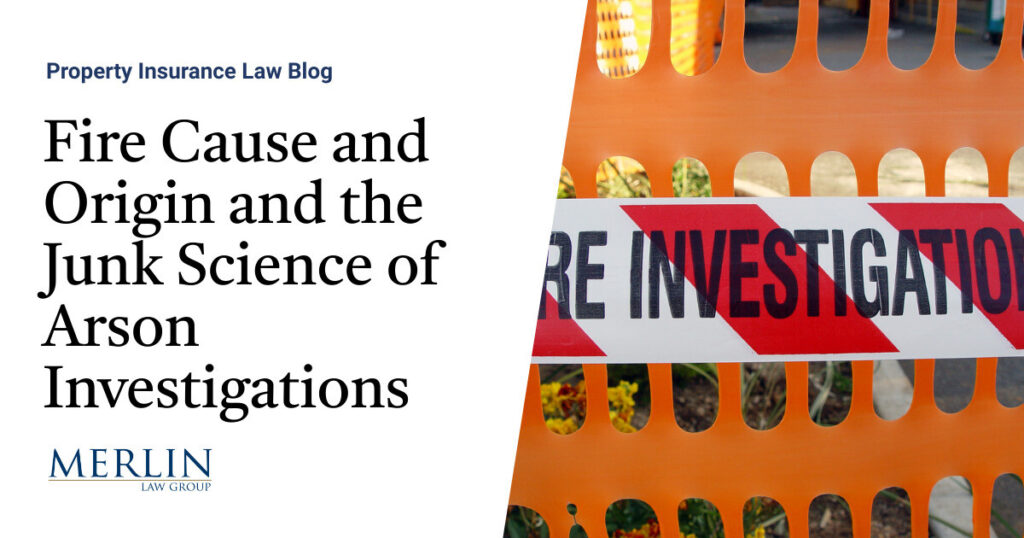Fire Cause and Origin and the Junk Science of Arson Investigations

Fire investigator Mike Koster of Reliant Investigations was a featured speaker at the Pacific Coast Association of Public Insurance Adjusters (PCAPIA) Spring Conference this week. I was impressed with his knowledge of physics, chemistry, and fire dynamics. It was not always this way in the fire investigation field, where many people were wrongfully accused and convicted of arson for profit. Many fire investigators, while often being well-meaning, were incompetent and improperly trained to make such opinions about the origin, cause and spread of a fire.
An ABA Journal article, Long-held Beliefs About Arson Science Have Been Debunked After Decades of Misuse, noted that hundreds of people were wrongfully convicted of arson based on junk science. Some were even executed. The article noted in part:
For decades, fire investigators relied on a set of erroneous beliefs and assumptions, akin to folklore, about what were thought to be the telltale signs of arson that were passed down from one generation to the next and accepted at face value.
Most investigators, whose jobs were to ‘catch arsonists,’ were former police officers or firefighters with little or no scientific background or training. They learned on the job by watching experienced investigators who learned the trade from their superiors, perpetuating a belief structure that still influences some practitioners today.
At the time, the investigation of fires was viewed more as an art than a science, a mix born of experience and intuition. Fire debris was read like tea leaves. And investigators routinely interpreted the artifacts of a fire—burn patterns, charred wood, melted metal, collapsed furniture springs, spalled (chipped or scaled) concrete and crazed glass—as surefire indicators of arson.
Some of those myths were based on what seemed like intuitively ‘obvious’ deductions, such as the notion that gas burns hotter than wood. Others were the result of unwarranted generalizations, like observing a pattern of spalling around the remains of a gasoline container and making an erroneous association between spalling and gasoline. But none of those so called arson indicators was grounded in science.
The last time I raised this historical junk science point was a decade ago in a blog noting my old foe, Steve Badger, in “Is Steve Badger’s View of Hail Damage Claims Fair and Balanced?” Badger had nothing to do with fire and arson claims, but I made this remark and quote:
Still, Badger’s points remind me a lot of what the Insurance Defense Attorney Macho Man Award winners from 1983 to 1990 were saying about fire claims. Most younger readers have no idea what I am talking about, but during those days, insurance defense attorneys were jumping all over each other trying to prove that policyholders were committing arson insurance fraud at an alarming rate. In the same rhetoric as Badger does with hail claims, they made out the customer to be the suspect of insurance fraud. Eventually, science disproved the rhetoric and myths championed by Macho Insurance Arson Attorneys:
In 1985, when the National Fire Protection Association (NFPA) Standards Council became sufficiently concerned about the validity of fire investigations, it appointed a Technical Committee to address the issue. Seven years later, the Committee and NFPA produced the first edition of NFPA 921, Guide for Fire and Explosion Investigations. The howls of protest from fire investigation ‘professionals’ were deafening. If what was printed in that document were actually true, it meant that hundreds or thousands of accidental fires had been wrongly determined to be incendiary fires. No investigator wanted to admit to the unspeakable possibility that they had caused an innocent person to be wrongly convicted, or a family to be wrongly denied their life savings. The profession was in denial. 1
I found it refreshing to listen to Koster because he noted how much science and mathematical formulas are necessary to properly analyze a fire scene. This type of knowledge and competency was extremely rare before the turn of the century.
Thought For The Day
It is far better to grasp the universe as it really is than to persist in delusion, however satisfying and reassuring.
—Carl Sagan
1 John Lentini, The Mythology of Arson Investigation, (the article is a summary of Chapter 8, from the author’s book, Scientific Protocols for Fire Investigation, 3rd Ed., CRC Press (2019)).







